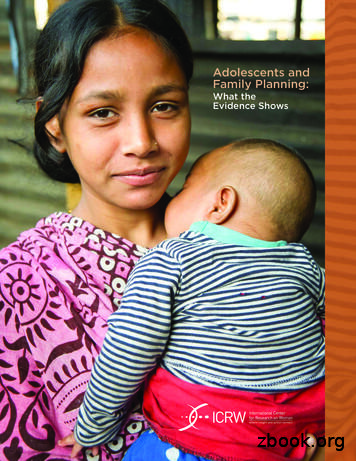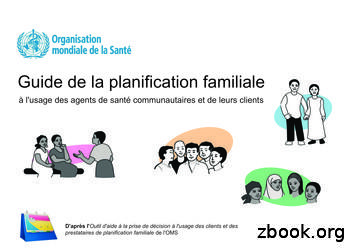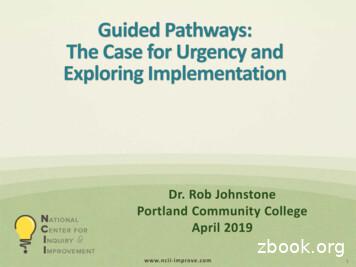Family Planning Methods - FPHandbook
7Family PlanningMethodsIntr o d uctio nWomen, men, or couples can choose from many contraceptive methods tohelp them plan their family and prevent an unplanned pregnancy. They needto know that if they are having sex regularly and do not use a contraceptivemethod, about 8 of every 10 women will become pregnant during the next12 months.Different people want different things from acontraceptive method. Some want a methodthat guarantees there is no chance ofpregnancy. Some want a quick return tofertility so they can get pregnant soon afterstopping a contraceptive method. Some donot want to think about contraceptivesevery time they have sex. Some do notwant to depend on their partner for thesuccess of the method. Some women donot want to remember to take a dailym a le con dompill, while others find that is easy.And there are still other factors thatinfluence method choice. Some mayneed protection from STIs and willchoose condoms to be used alone orin addition to another contraceptivemethod. Some people want a method(Continued on page 56)54Facts for Family Planningf emal e con domOnly male and female condoms providegood protection against STIs/HIV. Noother contraceptive method should beused for this purpose.
CHAPTERFamily PlanningmethodsKE Y FA CT S T O S H A R E : fa mi ly p la nni ng7: methods1.7 ormonal contraceptive methods include oralHcontraceptives pills, injectables, and implants. Theyall prevent pregnancy mainly by stopping a woman’sovaries from releasing eggs. Hormonal methodscontain either one or two female sex hormones thatare similar to the hormones naturally produced bya woman’s body.2. ral contraceptive pills should be taken one pillOevery day. They are most effective when no pills aremissed, the pill is taken at the same time every day,and each new pack of pills is started without a delay.3.I njectable contraceptives are given by injectioninto a woman’s arm or buttocks once every 1, 2,or 3 months, depending on the type of injectable.Injectables are most effective when womenremember to come back for re-injection on time.4. ontraceptive implants are inserted under the skinCof a woman’s upper arm and provide continuous,highly effective pregnancy protection for 3 to 5 years,depending on the type of implant. When this time isover, new implants can be inserted during the samevisit that the old set is removed.(Continued on page 57)Facts for Family Planning55
7CHAPTER 7:family planning methodsthey can always get easily whenever they need more. Some people preferfertility awareness methods because of religious beliefs, because they areworried about side effects, or do not like other methods. Some women wanta method that their partner will not know they are using. A few may have amedical condition that could affect the safe use of a particular method.For many people, the effectiveness of a family planning method is important.The chart below compares the effectiveness of methods as commonly used.The most effective methods are grouped at the top, and less effective methodsare at the bottom.Providers can help women, men, and couples think about their preferencesand their situations and choose the method that best suits them. Manywomen seeking family planning services already know which method theywant, and counselors should provide this method along with accurate andcomplete information, either themselves or through a referral. It is theprovider’s job to ensure that a client makes an informed voluntary choice andis not denied a method. In rare cases, a client may have a medical conditionthat will affect which method they can safely use.56Facts for Family Planning
KE Y FA CT S T O S H A R E : fa mi ly p la nn i ng method s5. mergency contraceptive pills (ECPs) can helpEprevent pregnancy if taken within 5 days afterunprotected sex. The sooner they are taken, the moreeffective they are. They are NOT meant to be used forongoing contraception, in place of a regular method.6.I ntrauterine contraceptive devices (IUDs or IUCDs)are small, flexible plastic devices that are insertedinto the woman’s uterus. The most common IUDscontain copper, and they work by preventing spermfrom reaching an egg. Depending on the type, IUDscan provide protection for 5 to 12 years.7. arrier methods are either devices (male and femaleBcondoms) that physically block sperm from reachingan egg, or chemicals (spermicides) that kill ordamage the sperm in the vagina. The effectiveness ofbarrier methods greatly depends on people’s ability touse them correctly every time they have sex.8. ertility awareness methods require a couple to knowFthe fertile days of the woman’s menstrual cycle — thedays when pregnancy is most likely to occur. Duringthese fertile days the couple must avoid sex or use abarrier method to prevent pregnancy.(Continued on page 58)Facts for Family Planning57
7KEY FACHAPTERCT S T7:OfamilySH A RplanningE : fa mi lymethodsp la nn i ng me t hods9. Breastfeeding provides contraceptive protectionfor the first 6 months after delivery if certainconditions are met. This approach is called theLactational Amenorrhea Method or LAM.101158.Withdrawal involves a man withdrawing his penisduring sex and releasing his ejaculate, whichcontains sperm, outside the woman’s vagina. Formost people withdrawal is one of the least effectivecontraceptive methods. Female and male sterilization are permanentmethods of contraception. Sterilization involves arelatively simple surgical procedure that provideslife-long protection against pregnancy. Sterilizationis appropriate for men and women who are certainthey do not want more children.Facts for Family Planning
CHAPTER 7:Family Planning methods7Su p p orti ng In f or mati onFact 1.Hormonal contraceptive methods include oral contraceptives pills,injectables, and implants. They all prevent pregnancy mainly bystopping a woman’s ovaries from releasing eggs. Hormonal methodscontain either one or two female sex hormones that are similar to thehormones naturally produced by a woman’s body.Hormonal methods are highly effective in preventing pregnancies, and nearlyall women can use them. All hormonal methods work by preventing thewoman’s ovaries from releasing an egg every month. Without an egg, there isnothing for sperm to join with — known as fertilizing the egg — so pregnancycannot occur. They also cause the mucus produced by the cervix to becomevery thick which prevents sperm from entering the uterus.Hormonal methods include oral contraceptive pills, injectables, and implants.Each is used differently, has somewhat different side effects, and has slightlydifferent advantages and limitations. It is helpful if a woman talks with ahealth care provider to make sure she has no health conditions that may makea method unsuitable, to learn thespecifics about the method, andNone of the hormonal methods can harmto choose one that is right for her.a pregnancy or a baby if accidentally takenSome hormonal methods are shortby a woman who is already pregnant.acting, and some are long-acting.The short-acting hormonal methodsrequire either taking a pill everyday or getting repeat injections as scheduled. They are very effective whenused correctly. They are somewhat less effective when women forget to take apill or to return for an injection on time. Implants are long-acting hormonalmethods, and they are highly effective because, once inserted in the woman’sarm, the woman will not require further action for 3 to 5 years depending onthe implant being used.Facts for Family Planning59
7CHAPTER 7:Family Planning methodsFact 2.Oral contraceptive pills should be taken one pill every day. They aremost effective when no pills are missed, the pill is taken at the sametime every day, and each new pack of pills is started without a delay.Combined oral contraceptives (COCs). The most commonly used oralcontraceptive pills combine two synthetic hormones — estrogen andprogestin. These oral contraceptives are often referred to ascombined pills or simply “the Pill.” If a womanremembers to take the Pill every day, the methodis close to 100% effective in preventing pregnancy.However, since some women forget, on average overthe course of a year, 8 pregnancies will occur amongevery 100 women taking the Pill.Some women experience side effects when first taking the Pill, such as nauseaor mild headaches, but the side effects are not dangerous and usually go awayafter the first few months. Breastfeeding women should delay starting the Pilluntil the baby is at least 6 months old because the estrogen in the Pill mightreduce the amount of breast milk.Progestin-only pills (POPs). Another type of oral contraceptive pills containsonly one synthetic hormone — progestin. These pills are often calledprogestin-only pills or the “mini-pill.”Progestin-only pills are recommended for breastfeeding women because,unlike estrogen, progestin will not reduce the production of breast milk.Also, progestin-only pills are more effective in breastfeeding than in nonbreastfeeding women. For women who are not breastfeeding, the mini-pillmay not be as effective as the combined estrogen and progestin pill.The effectiveness depends on taking the mini-pill at about the same timeevery day.60Facts for Family Planning
CHAPTER 7:Family Planning methods7Women who are taking progestin-only pill may experience irregular lightbleeding and spotting. This is not harmful, although may be inconvenient forsome women.All oral contraceptives. There is no delay in returning to fertility after awoman stops using either combined pills or progestin-only pills. ThePill is usually readily available at pharmacies as well as clinics, and fromcommunity-based providers.Fact 3.Injectable contraceptives are given by injection into a woman’s armor buttocks once every 1, 2, or 3 months, depending on the type ofinjectable. Injectables are most effective when women remember tocome back for re-injection on time.Injectable contraceptives are given by injection intoa woman’s arm or buttocks in either the muscle orunder the skin in the fatty tissue, depending ontype of injectable. After the injection, the hormoneis released slowly from the injection site into the bloodstream. Differentinjectables require a woman to return for a repeat injection once every 1, 2,or 3 months.When women always remember to come for re-injection on time,injectable contraceptives are close to 100% effective. However, some womenoccasionally are late for re-injection. On average, over the course of a year, 3pregnancies will occur among every 100 women using injectables.The most common side effects of injectables are bleeding changes. At first,injectables may cause irregular, heavy, or prolonged bleeding, but afterFacts for Family Planning61
7CHAPTER 7:Family Planning methodsseveral injections many women stop having monthly bleeding altogether.This is especially common with the 2- and 3-month injectables. Having nobleeding pleases many women, but some may worry that something iswrong or that they are pregnant. They should know that having no bleedingsis harmless and does not cause permanent damage to a woman’s fertility.It can even be good for some women’s health because the absence of monthlybleedings reduces the risk of anemia (low iron level in the blood). Womenneed to be aware of these side effects in advance so they know what to expectand do not worry.Depending on the type of injectable, the return to fertility after a woman’slast injection is often delayed and may take from 4 to 10 months. A familyplanning counselor can help a couple to consider return to fertility when theyare selecting a method for timing or spacing pregnancies. A woman can getan injection at a clinic or health outpost. In many countries, communitybased health workers and pharmacists are able to administer injections.Fact 4.Contraceptive implants are inserted under the skin of a woman’s upperarm and provide continuous, highly effective pregnancy protection for 3to 5 years, depending on the type of implant. When this time is over, newimplants can be inserted during the same visit that the old set is removed.Implants are small plastic rods, each about the size of a matchstick.These rods are placed just under the skin on the inside of a woman’supper arm. Implants are almost 100% effective and can provide3 to 5 years of protection from pregnancy, depending on thetype of implant. Women have found implants to be among theeasiest family planning methods to use. After implants areinserted, there are no further actions to take or additionalcosts until they are removed.62Facts for Family Planning
CHAPTER 7:Family Planning methods7A woman must visit a trained health care provider to have implants put inher arm or to have them removed. To continue being highly effective, theyshould be removed and replaced promptly, in 3 to 5 years, depending on thetype of implant. A woman will become fertile again and able to get pregnantalmost immediately after the implants are removed. If a woman desires tocontinue to use implants, a new set can be inserted and the old ones do nothave to be removed.Side effects of implants include irregular vaginal bleeding and spotting. Somewomen’s monthly bleedings stop altogether. This pleases many women, butsome may worry that something is wrong or that they are pregnant. It isimportant to counsel women in advance that they may stop menstruatingand that this is harmless.Fact 5.Emergency contraceptive pills (ECPs) can help prevent pregnancy iftaken within 5 days after unprotected sex. The sooner they are taken,the more effective they are. They are NOT meant to be used for ongoingcontraception, in place of a regular method.Emergency contraceptive pills (ECPs) are sometimes referred to as the“morning-after pill” because they are taken after unprotected sex has takenplace. They contain either progestin alone or progestin and an estrogentogether, like oral contraceptives. However, the hormone dose in ECPs ishigher, and a woman takes only one or two pills.Emergency contraception works like any other hormonal method bypreventing ovulation. There is no evidence that ECPs prevent a fertilizedegg from attaching to the uterine lining.Facts for Family Planning63
7CHAPTER 7:Family Planning methodsECPs should not be used in place ofregular contraception because theyECPs do not protect against pregnancyare not as effective as most regularresulting from sex that happens after ECPsmethods. They are 75% to 95%have been taken.effective in preventing pregnancydepending on the type of ECP and onhow soon after unprotected sex thepills are taken. Providers should help women who use ECPs to choose a regularcontraceptive method for ongoing protection against pregnancy.ECPs have no serious side effects. Some women may have headaches, nausea,or vomiting after taking ECPs, but these go away within several days. The ECPsthat contain only progestin cause fewer side effects and are more effective.There is no delay in return to fertility after taking ECPs. Because of this, ECPsprevent pregnancy only after unprotected sex that occurred within the previous5 days. ECPs will not prevent pregnancy resulting from unprotected sex thattakes place after ECPs have been taken.ECPs offer women a second chance to prevent pregnancy after unprotectedsex. They do not cause an abortion, and, if taken accidentally by a woman whois already pregnant, they will not harm the woman or the fetus or disrupt thecourse of pregnancy.Fact 6.Intrauterine contraceptive devices (IUDs or IUCDs) are small, flexibleplastic devices that are inserted into the woman’s uterus. The mostcommon IUDs contain copper, and they work by preventing sperm fromreaching an egg. Depending on the type, IUDs can provide protection for5 to 12 years.64Facts for Family Planning
CHAPTER 7:Family Planning methods7An IUD is a small, often T-shaped plastic device that is wrapped in copper orcontains a progestin hormone. A specially trained health care provider insertsthe IUD into the uterus. A plastic string tied to the end of the IUD hangs downthrough the cervix into the vagina. A woman can check that the IUD is inplace by feeling for this string inside the vagina. A health care provider uses thestring to remove the IUD when the woman wants it removed or it eventuallyneeds to be replaced. Women who are not pregnant can have an IUD insertedany time. After childbirth, women can have an IUD inserted immediately orwithin the first two days. If not, she will need to wait four to six weeks to do so.IUDs are nearly 100% effective. They are long-acting, too. Once in place, theycan provide 5 to 12 years of protection from pregnancy, depending on thetype of IUD. However, a woman can ask to have the IUDtaken out at any time. When the IUD is removed, a womancan get pregnant immediately. Women have found theIUD to be among the easiest family planning methods touse: after it is inserted into the uterus there are no furtheractions a woman must take and no additional costs untilthe IUD is removed. Women of all ages can use IUDs,whether or not they have had children. It does notcause infertility.Women living with HIV can safely use IUDs. However, women at veryhigh risk of STIs or who currently have an active STI, such as gonorrhea orchlamydia, should not have an IUD inserted. The process of inserting theIUD could push gonorrhea and chlamydia higher into the reproductive tractcausing a more serious health problem. These infections should be treatedand cured prior to IUD insertion.Copper-bearing IUD. The copper-bearing IUD works by creating anenvironment in the uterus that damages the sperm and keeps them fromuniting with an egg. It is effective for up to 12 years. The most common sideeffects of the copper IUD include heavier and longer monthly bleeding,Facts for Family Planning65
7CHAPTER 7:Family Planning methodswhich may be accompanied by increased cramping. For most women theseside effects diminish or disappear after the first 3 to 6 months of IUD use.Hormonal IUD. A hormonal IUD very slowly and continuously releases asmall amount of a progestin hormone. It works by thickening the cervicalmucus, making it hard for sperm to pass from the vagina into the uterus.It also prevents ovulation in some women and keeps the lining of the uterusfrom growing.Once in place in the woman’s uterus, the hormonal IUD is highly effectiveand can be used for up to 5 years. The hormonal IUD also changes bleedingpatterns, in this case a woman bleeds less and on fewer days, and the bleedingcould be irregular. In fact, many women have no bleeding at all after severalmonths of using this method. Lighter bleeding is a benefit to many women,particularly those with anemia.Fact 7.Barrier methods are either devices (male and female condoms)that physically block sperm from reaching an egg, or chemicals(spermicides) that kill or damage the sperm in the vagina. Theeffectiveness of barrier methods greatly depends on people’s abilityto use them correctly every time they have sex.The most common barrier family planning method is the male condom.Male and female condoms are the only contraceptive methods that provideprotection from STIs, including HIV, in addition to pregnancy. Less commonbarrier methods are diaphragms and cervical caps; they are not readilyavailable in many countries. All of these devices form a mechanicalbarrier between the sperm and an egg. Finally, spermicides are chemicalsubstances placed in the vagina — a foam, a gel, film, or a tablet, for example.Spermicides work by killing or disabling sperm.66Facts for Family Planning
CHAPTER 7:Family Planning methods7Barrier methods should be used every time a couple has sex. The effectivenessof barrier methods depends greatly on people’s ability to use them consistentlyand correctly. If a woman is fertile and does not use the method consistentlyand correctly, she can become pregnant.Male condom. A male condom is a covering — usually made of thin latexrubber — that unrolls over a
60 Facts for Family Planning 7 CHAPTER 7: Family Planning methods fACT 2. oral contraceptive pills should be taken one pill every day. They are most effective when no pills are missed, the pill is taken at the same time every day, and each new pack of pills is started without a delay. Combined oral contraceptives (CoCs). The most commonly used oral
Catan Family 3 4 4 Checkers Family 2 2 2 Cherry Picking Family 2 6 3 Cinco Linko Family 2 4 4 . Lost Cities Family 2 2 2 Love Letter Family 2 4 4 Machi Koro Family 2 4 4 Magic Maze Family 1 8 4 4. . Top Gun Strategy Game Family 2 4 2 Tri-Ominos Family 2 6 3,4 Trivial Pursuit: Family Edition Family 2 36 4
family planning information and services. All of these studies used experimental or quasi-experimental methods. While not every study focused specifically on adolescents and family planning (i.e., some included family planning for adults or primarily addressed HIV prevention), all included some level of attention to adolescent family planning in-
Figure 3. Important Considerations for Family Planning in the PHC Service Delivery Components The government believes that integrating family planning with PHC will increase family planning coverage and improve overall population health. Malawi has made progress in creating and meeting demand for family planning, but it has a long way to
aux besoins du client. Pour le faire, écoutez le client et évaluez sa situation, ses besoins et ses souhaits. Exprimez-vous de manière compré hensible pour le client. Ne lisez pas le texte au client. Lorsque vous connaîtrez bien le guide, un coup d'œil suffira à vous rappeler les informations clé et ce qu'il faut faire. Méthodes
Story – Talk of the Block Family SV, “Kim and the Kids,” pg 9-10 Volunteer’s family pictures (if possible) Family worksheet (see below) Activity Ideas: Family tree: T introduces family by talking about own family and drawing a very simplified family tree on the board using the family vocabulary words (see above). Feel free to bring
Gateway Math & English Completion in 1. st. . FAMILY FEUD FAMILY FEUD FAMILY FEUD FAMILY FEUD FAMILY FEU FAMILY FEUD FAMILY FEUD FAMILY FEUD FAMILY FEUD FAMILY FE. National Center for Inquiry & Improvement www.ncii -improve.com Round 1: What Do New Students Ask .
A. Family Office Detailed Background Data B. Family Office Investment Objectives and Asset Management C. Family Office Risk and Return Measurements D. Family Office Governance E. Family Office Documentation F. Family Office Processes G. Family Office Communications H. Family Office Human Resources Practices I. Family Office Education and .
THE SECRET LANGUAGE OF DESIGNED BY EIGHT AND A HALF BROOKLYN, NY SCIENCE, NATURE, HISTORY, CULTURE, BEAUTY OF RED, ORANGE, YELLOW, GREEN, BLUE & VIOLET JOANN ECKSTUT AND ARIELLE ECKSTUT 15213_COLOR_001-009.indd 3 7/3/13 12:18 PM. Joann Eckstut is a leading color consultant and interior designer who works with a wide range of professionals including architects, developers and manufacturers of .























